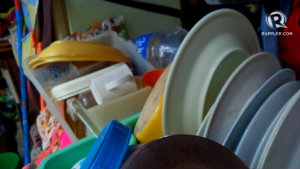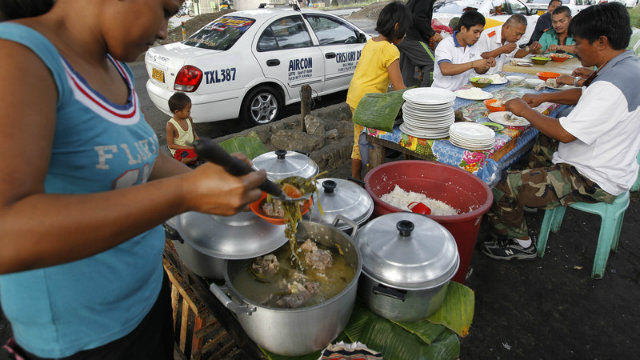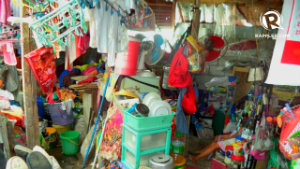SUMMARY
This is AI generated summarization, which may have errors. For context, always refer to the full article.
MANILA, Philippines – How much money do you spend to feed an entire family?
For many poor Filipino households, the answer is “not much.”
To save money and time, Jocelyn relies on the neighborhood karinderya to feed her family. She spends P60-P80 per meal to feed 8 hungry mouths. In a day, this totals to around P240 – this may not seem much to others, but for families like Jocelyn’s, this is already more than half of their day’s earnings.
Jocelyn earns P600-P800 a month collecting and selling junk; sometimes there are good finds, sometimes none. If you break this down, her daily earning is no more than P30. Meanwhile, her husband Rogelio earns P300 per day as an office clerk.
They get their water by the bucket, which sells for P3 each. Since Rogelio has ulcer, the family has to pay extra for his bottled water.
Sometimes they have electricity, but today they didn’t. “Baka mahuli ng Meralco e, naka-jumper kami,” Jocelyn explained why the electric fan suddenly stopped working. (We might get caught by Meralco, we’re using a jumper.)
The karinderya keeps the family alive, but it also keeps the couple in debt. “Ang kita namin, halos lahat napupuntang pambayad utang sa tindahan,” Jocelyn said. (Almost all our earnings are used to pay debts at the store.)
But the family has to go on eating, even if it means living on a few unhealthy meals.
The usual menu
Small karinederyas are found in almost all communities across the country, both in urban and rural settings. The latter may have a more diverse menu to offer, including vegetable dishes, but those in the Metro usually serve monotonous meat dishes.
“Walang gastos sa sahog, uling o gasul, kaya mas gusto ng maraming pamilya dito,” explained Kim Mandigma, a nutritionist-dietitian closely monitoring the community in Caloocan where Jocelyn lives. (No spending on ingredients, charcoal or gas, that’s why many families prefer karinderyas.)
For example, Jocelyn usually buys rice and 4 small pieces of fried chicken for dinner – 8 people will then split the chicken among themselves. Other popular choices include inihaw na baboy (grilled pork), lechon kawali, and anything fried.
“Karinderyas provide a relatively cheaper source of meals for many, but most often foods served are salty, oily, fatty, and have limited choices especially of vegetable viands,” said Jovie Raval, Nutrition Information and Education Division Chief of the National Nutrition Council (NNC).
Raval also cited the 2008 National Nutrition Survey which revealed that “40.3% of households surveyed take their meals outside of their homes which is largely caused by urbanization and increased incomes.” As in the case of eating fast food and instant meals, common among students and young workers.
But in the case of Jocelyn’s family, their income has not increased in years.
These menus usually lack the necessary vitamins and minerals; such “monotonous diets” may impact on a person’s health – especially on children’s physical and mental development.
It can also discourage children from developing a taste for fruits and vegetables. Junk foods are commonly sold even to very young children.

Mandigma advised Jocelyn to at last reheat the meals she buys, however, the family does not have access to a functioning stove at all times. “Pero nagluluto kami ‘pag weekends o bagong sahod,” Jocelyn shared. (But we also cook during the weekends or after payday.)
The couple plants their own malunggay, which Jocelyn has been experimenting with. “Pwedeng lagyan ng malunggay kahit ano,” the mother quipped. (You can add malunggay to anything.) Aside from soups, she also adds malunggay to her iced tea. Her other experiments include adobo with honey, pinakbet with tomato sauce, and sinangag (fried rice) with malunggay.
Jocelyn is from the Cagayan Valley and grew up on vegetables; she also attends nutrition and cooking lessons sponsored by the barangay, local daycare and health centers. “Magaling naman talaga ako magluto, ang problema, wala akong pera para panluto,” she said. (I’m actually a good cook, the problem is that I don’t have money to spend on cooking.)
Healthier karinderyas

Mandigma observed that quality and quantity rarely match among poor households. “In some families, the quality is okay, but the quantity is not.” Just like in the case of Jocelyn’s family, they only get to eat nutritious meals once or twice a week.
While in other families, food may be plenty – such as rice, instant noodles, or canned goods – but this does not mean that they are eating right.
Mandigma is part of Children International (CI) Manila, a non-governmental organization championing the rights of the vulnerable. The organization is currently planning a program which aims to train karinderya owners on proper meal planning and preparation. “Mula sa simpleng kalinisan, hanggang sa tamang mga sahog ituturo,” Mandigma said. (From simple cleanliness, up to choosing the right ingredients, we’ll teach them.)
CI Manila wants to partner with local government units (LGU) and concerned government agencies once the program is in full swing.
“A program to help karinderya owners to have healthier food options that ensure food safety would be very welcome to consumers. The program can be designed to develop model karinderyas that offer nutritious and safe foods,” Raval commented.
She added that the “Pinggang Pinoy” may be used as a guide in developing menus.
All of this, however, remains an idea.

Her husband and children will be home soon, so Joceyln makes her trip to her favorite karinderya. What will be tonight’s meal? It did not really matter for her anymore, what mattered was that they will have something to fill their stomachs for another day, whatever the consequences may be. – Rappler.com
For those who are interested in discussing more about Children International Manila’s plans on training karinderyas, you may reach them at 937-0161 or soa@mla.children.org.ph.
How can we help fight hunger? Report what your LGU is doing, recommend NGOs, or share creative solutions. Send your stories and ideas to move.ph@rappler.com. Be part of the #HungerProject.
Add a comment
How does this make you feel?

There are no comments yet. Add your comment to start the conversation.